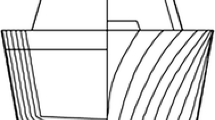Abstract
In this paper, the effect of the above-waterline hull shape on broaching danger in irregular stern-quartering waves was numerically investigated using the US Office of Naval Research (ONR)-tumblehome and ONR-flare hulls. To indicate the danger of broaching, the probability of a broaching-induced large roll angle of the two vessels was examined along with the probability of broaching. The numerically estimated broaching-induced roll angles were compared with the time histories of the free-running model experiments. Then, the effects of above-waterline hull shape on broaching danger in the North Atlantic were simulated for various speeds, autopilot courses and rudder gains.











Similar content being viewed by others
Abbreviations
- a H :
-
Rudder force increase factor
- A R :
-
Rudder area
- F N :
-
Rudder normal force
- f α :
-
Rudder lifting slope coefficient
- J P :
-
Advance coefficient of propeller
- l R :
-
Correction factor for flow-straightening effect due to yaw rate
- N R :
-
Rudder-induced yaw moment
- U :
-
Ship speed
- U R :
-
Resultant rudder inflow velocity
- u R :
-
Longitudinal inflow velocity component to rudder
- v R :
-
Lateral inflow velocity component to rudder
- w P :
-
Wake coefficient at propeller position
- w R :
-
Wake coefficient at rudder position
- X :
-
Calm-water ship resistance
- x HR :
-
Longitudinal position of additional lateral force due to rudder
- x R :
-
Longitudinal position of rudder
- Y R :
-
Rudder-induced sway force
- α R :
-
Rudder inflow angle
- β :
-
Drift angle
- \(\gamma\) :
-
Flow-straightening coefficient for drift angle
- \(\delta\) :
-
Rudder angle
- ε :
-
Ratio of wake fraction at propeller and rudder position
- \(\rho\) :
-
Water density
- θ :
-
Pitch angle
- \(\kappa\) :
-
Propeller inflow speed increase constant
- η :
-
Ratio of propeller diameter to rudder span
- ξ G :
-
Longitudinal position of the centre of the ship’s gravity from a wave trough
- \(\varphi\) :
-
Roll angle
- χ :
-
Heading angle from wave direction
References
Bassler C, Peters A, Campbell B, Belknap W, McCue L (2007) Dynamic stability of flared and tumblehome hull forms in waves. In: Proceedings of the 9th International Ship Stability Workshop, 6–4, pp 1–14
McCue L, Campbell B, Belknap W (2007) On the parametric resonance of tumblehome hullforms in a longitudinal seaway. Naval Eng 119:35–44
Bassler C (2008) Application of parametric roll criteria to naval vessels. In: Proceedings of the 10th International ship stability workshop, pp 57–70
Umeda N, Usada S, Mizumoto K, Matsuda A (2016) Broaching probability for a ship in irregular stern-quartering waves: theoretical prediction and experimental validation. J Mar Sci Technol 21:23–37
Araki M, Umeda N, Hashimoto H, Matsuda A (2012) An improvement of broaching prediction with a nonlinear 6 degrees of freedom model. J Jpn Soc of Nav Arch Ocean Eng 14:85–96
Hashimoto H, Umeda N, Matsuda A (2011) Broaching prediction of a wave-piercing tumblehome vessel with twin screws and twin rudders. J Marine Sci Technol 16:448–461
Furukawa T, Umeda N, Matsuda A, Terada D, Hashimoto H, Stern F, Araki M, Sadat-Hosseini H (2012) Effect of hull form above calm water plane on extreme ship motions in stern quartering waves. In: Proceedings of 29th Symposium on Naval Hydrodynamics, Gothenburg, Sweden
Umeda N, Furukawa T, Matsuda A, Usada S (2014) Rudder normal force during broaching of a ship in stern quartering waves. In: Proceedings of the 30th ONR Symposium on Naval Hydrodynamics, Hobart, Australia
Thet Zaw Htet, Umeda N, Maki A, Matsuda A, Terada D (2017) Estimation of broaching probability using wave-induced forces and moments measured in captive model tests. J Mar Sci Technol (published online)
Renilson M (1997) A note on the capsizing of vessels in following and quartering seas. Ocean Eng Int 1:25–32
Motora S, Fujino M, Fuwa T (1982) On the mechanism of broaching-to phenomena. In: Proceedings of the 2nd International Conference on Stability and Ocean Vehicles, The Society of Naval Architects of Japan, Tokyo, pp 535–550
Yasukawa H, Yoshimura (2015) Introduction of MMG standard method for ship maneuvering predictions. J Mar Sci Technol 20:37–52
Umeda N, Yamakoshi Y, Suzuki S (1995) Experimental study for wave forces on a ship running in quartering seas with very low encounter frequency. In: Proceedings of the International Symposium on Ship Safety in a Seaway, vol 14, pp 1–18
Maki A, Umeda N, Renilson MR, Ueta T (2010) Analytical formulae for predicting the surf-riding threshold for a ship in following seas. J Marine Sci Technol 15:218–229
Longuet-Higgins MS (1983) On the joint distribution of wave periods and amplitudes in a random wave field. Proc R Soc Lond Ser A389:241–258
Umeda N, Hashimoto H (2002) Qualitative aspects of nonlinear ship motions in following and quartering seas with high forward velocity. J Mar Sci Technol 6:111–121
IACS (2001) Standard wave data, recommendation no. 34
Acknowledgements
This work was supported by the US Office of Naval Research Global Grant no. N62909-13-1-N257 under the administration of Dr. Woei-Min Lin and a Grant-in Aid for Scientific Research from the Japan Society for Promotion of Science (JSPS KAKENHI Grant no. 15H02327). The authors would like to thank Enago (http://www.enago.jp) for the English language review.
Author information
Authors and Affiliations
Corresponding author
Appendix
Appendix
The rudder forces and moments were calculated by the following equations [12]:
About this article
Cite this article
Thet Zaw Htet, Umeda, N., Matsuda, A. et al. Effect of above-waterline hull shape on broaching-induced roll in irregular stern-quartering waves. J Mar Sci Technol 24, 166–173 (2019). https://doi.org/10.1007/s00773-018-0544-4
Received:
Accepted:
Published:
Issue Date:
DOI: https://doi.org/10.1007/s00773-018-0544-4



